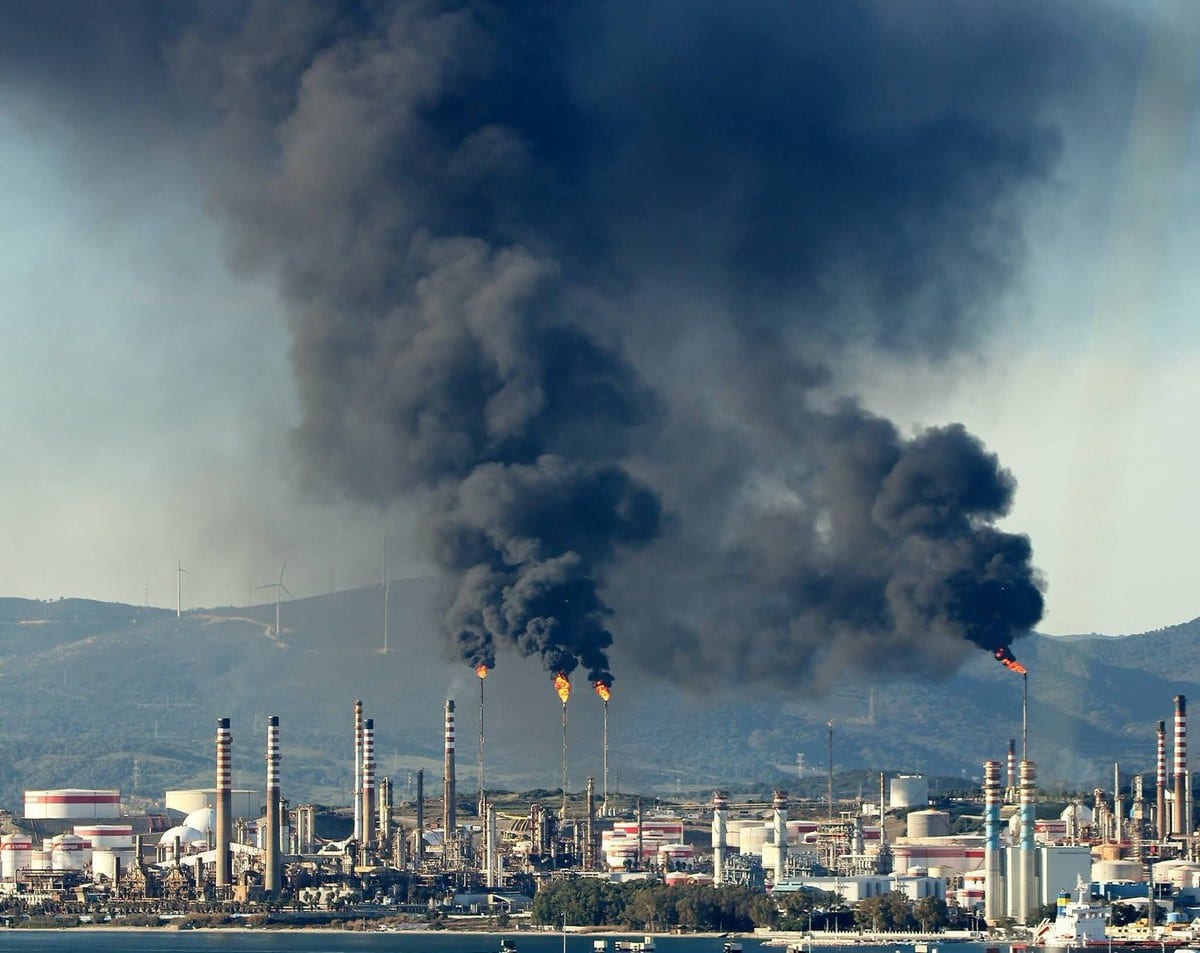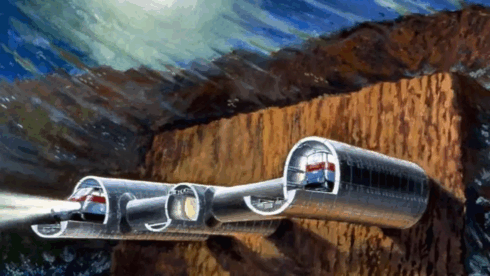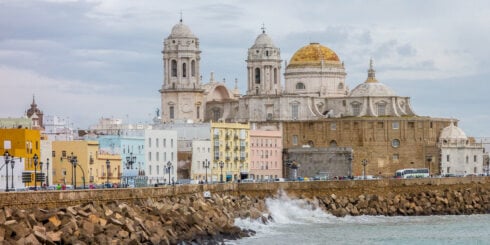
WHEN Gibraltar’s tourist board coined the marketing slogan ‘More than you can imagine’, they weren’t counting on the World Health Organisation (WHO) to confirm it.
But according to its damning new study, there’s more pollution on the Rock’s borders than most other places in the world. And the smoky clouds drifting across the frontier from the Campo de Gibraltar’s petrochemical chimneys don’t need to be imagined.
They can be seen on a daily basis.
Gibraltar borders Cadiz, which has the dirtiest air of any province in Spain, according to the new WHO report.
And while La Linea ranks as the 30th most polluted place in the world – on a par with industrial hotspots like Delhi – the Rock has the second worst pollution in the UK, after Scunthorpe.
And no wonder! A stone’s throw away in the Bay of Algeciras sits the Acerinox stainless steel works, to the north is the petrochemical plant PETRESA and next to that, on the Guadarranque Industrial Estate, the sprawling CEPSA refinery, dubbed by locals as the ‘Hollywood of Spain’ for its incredible bright lights and flares that shoot out at night.

But there is nothing vaguely stardust-y in the new WHO report, which is causing untold distress to residents who have feared for years that they are at a higher risk of cancer.
And those fears are not imagined either. The Campo officially sits at the centre of the ‘cancer triangle’ of Sevilla, Cadiz and Huelva, cities which top Spain’s list of cancer deaths according to a Health Ministry study.
It is easy to see how the black pollution clouds generated by CEPSA’s gas flares drift across to Gibraltar, but the Rock is even more of a magnet for pollution than imagined.
The prevailing easterly and westerly winds funnel any pollutants through Gibraltar, while the Rock’s geology attracts a build up of clouds overhead, hence the grey Levanter cloud that often hovers over the peninsula like a shroud.
One health expert this week told the Olive Press ‘it is a complex situation’ and that the CEPSA refinery and pollution could not alone be blamed for cancer rates in the area.
“The border was closed for 25 years,” the source said, “so you have a whole generation who did not have access to fresh fruit and vegetables.
“There are also more cars, more buildings and more ships, but the politicians play down the cancer risk because they want investment in Gibraltar and don’t want it to be seen as a dangerous place.”

So should Rock and Campo residents be worried?
That’s an emphatic ‘No’ from Gibraltar Health Services Cancer Services Coordinator, Isobel Ellul. “We don’t link cancer to pollution”.
Despite her important cancer work, for which she was awarded an MBE in 2011, the mother-of-two does not seem overly concerned with the threat posed by pollution.
“Our numbers are comparable to the rest of the EU,” insisted the former MP and founder of Gibraltar’s Breast Cancer Awareness Charity. “It is very difficult to link the two.”
Indeed, pollution data for 2018 shows that Gibraltar is in line with the EU’s target levels of pollution for benzene and carbon monoxide, which are PM2.5 and PM10.
PM2.5 and PM10 are incredibly small particulate matter, and PM2.5 is particularly dangerous, because its tiny size means it hangs in the air for a long time.
However, the same cannot be said for known carcinogen nitrogen dioxide (NO2), which exceeds the targets set by the EU’s Air Quality Directive by 25%.
The 2018 NO2 average so far is 56 µg/m3, which significantly exceeds the EU limit of 40 µg/m3 (see graph).

“From an environmental point of view it’s not ideal, but I think it’s one of those realities, that one in three people are going to get cancer,” Ellul told the Olive Press.
“Yes, I am worried in general but no, I am not more worried about Gibraltar than anywhere else in the world.”
Her relaxed attitude is echoed by those in power on the Rock, who have been relatively slow to move on the toxic air threat, particularly in relation to transport.
The government’s most significant effort at understanding the link between pollution and cancer was an epidemiological study commissioned way back in 2010.
Conducted by professors Hans Sanderson and Patrik Fauser of the National Environmental Research Institute at Denmark’s AARHUS University, the study set out to establish ‘whether Gibraltar is a high-risk community for cancer’; and whether there was a ‘greater than expected incidence of cancer in Gibraltar’.

A categorical ‘no’ was the answer to both hypotheses: ‘Gibraltar is not a high-risk community for cancer,’ they concluded.
But their study used data from 2008, now a decade old, and follow-up scientific analysis has been apparently scant.
Indeed, it is incredibly hard to find in-depth studies on the pollution risks to health on both sides of the border.
While a study was allegedly conducted by the Royal Navy in 2011 in reference to pensions, for various reasons it was not apparently released.
“It was a risk study for soldiers in Gibraltar, which found that cancer rates were higher than expected,” a well placed source revealed.
“It was connected to pensions and future health planning as I understand it,” they added. “It made for pretty damning reading.”
Another healthcare professional Grainne McKenna, of the Rock’s longest-serving cancer charity Cancer Relief, confirmed it was very hard to get concrete facts.
“To the best of my knowledge there are no published researched studies or statistics in this field,” she said.
However, the ensuing years have seen dozens of media reports documenting the views of residents worried about the health effects of pollution.
One of the most emotive accounts was across the border about a household plagued by cancer, including a five-year-old girl with a brain tumour.

The Rivas family live just 25m away from San Roque’s CEPSA refinery, reported the El Español article in 2017, which made for harrowing reading.
“Here you don’t breathe oxygen, you breathe poison, and it extends throughout the province depending on the winds,” said Carmen Rivas.
“The smell of gas gets into your head, just above the nasal septum, and then your head hurts. It’s horrific.”
Now the topic is very much back in the public eye, after Ecologistas en Accion launched a lawsuit against the Junta for ‘failing to tackle toxic air’.
The green group alleges that over 10,000 tonnes of pollutants were released into the atmosphere last year.
This might explain why so many Gibraltarians and people living in the Campo regularly suffer sore and itching throats and eyes.
Someone who witnesses the CEPSA refinery ‘ash clouds’ on her daily commute and directly helps those living with cancer is Heidi Jeffries, secretary of local charity Breast Cancer Support.
She believes cancer rates in Gibraltar are well exceeding anywhere else in the EU.
“For me, pollution is a problem,” she told the Olive Press.

She was clear, however, that her personal views do not necessarily reflect those of the charity, adding that traffic congestion in Gibraltar was equally to blame.
“A good percentage of Gibraltarians put the pollution down to cars and I think this causes more deaths,” she said.
Although the Gibraltar Health Association (GHA) support the charity Heidi works for, the health organisation is not obligated to provide data, including cancer statistics, to the public.
The government’s only annual statutory obligation is to produce the census and reports on employment, tourism, hotel occupancy and air traffic.
Pollution data is published by the Gibraltar Environmental Agency, and – perhaps somewhat dubiously – by the industries that sit along the Bay of Algeciras.
But in both cases, cancer statistics are conspicuous by their absence.
We can only go on local data and at Heidi’s small organisation alone they have seen a 25% increase in new cases of breast cancer this year, which is something of an alarming record.
“It is certainly high for us… and I think that is because of pollution,” insists Heidi.
But again, there is no data to back up such claims.
In fact, if anything it is the opposite.

The most recent government statistics, from 2015, show 235 registered deaths in Gibraltar of which 22% were due to cancer, down from 28% in 2014 and 31% in 2013.
Cervical cancer vaccinations, along with breast screening waiting times, appointment attendances, are the only ‘evidence’ publicly available.
One of the few follow-ups to the 2010 scientific paper was written by the same two Danish university professors together with fellow academic Per Lofstrom in 2013.
It focused on the prevalence of carcinogens within a 10km radius of Gibraltar and identified the main pollution sources, in particular Acerinox, which releases these chemicals as part of its welding of Stainless steel.
It’s conclusions: the carcinogen chromium was at critical levels in Gibraltar and those exposed to it have a heightened risk of lung and other respiratory cancers.
What is most unclear is exactly how far – and in what direction – these dangerous chemicals and the smoke from the Cepsa refinery spread.
It is generally believed that the prevailing winds take the pollution as much into Algeciras and Los Barrios, as they do towards Gibraltar and east towards Estepona and Marbella.

Do they reach as far as Jimena de la Frontera, as far as Ronda? What impact do they have on Sotogrande and Tarifa?
It is very hard to find out, but interesting to note that at least two engineers who work at the Cepsa plant told the Olive Press they would ‘not consider’ living in the Campo de Gibraltar with their families.
“I’m not taking any chances,” said one, who insisted on not being named.
With no complete picture the answer, as Bob Dylan sang, is blowing in the wind.
Pollution Watch Gibraltar are a platform on Facebook, where people in Gibraltar can raise their concerns about pollution. The group publishes advice and pollution maps using data collected by the European Space Agency’s SENTINEL 5-P satellite. They say they aim to ‘raise awareness about Gibraltar’s worsening pollution’.
Click here to read more News from The Olive Press.








